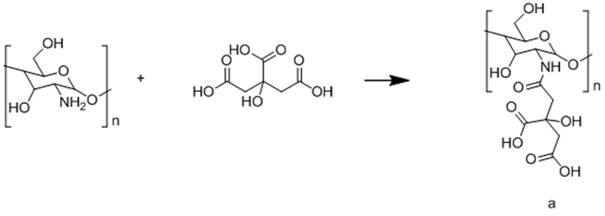An amphiphilic silica airgel composite material for wastewater treatment
A technology of silica and composite materials, applied in airgel preparation, water/sewage treatment, adsorbed water/sewage treatment, etc., can solve the problems of secondary pollution of adsorbed oil, slow oil absorption speed, and low treatment efficiency, and achieve Accelerated removal, increased coordination points, good pore connectivity
- Summary
- Abstract
- Description
- Claims
- Application Information
AI Technical Summary
Problems solved by technology
Method used
Image
Examples
Embodiment 1
[0031]An amphiphilic silica airgel composite material for wastewater treatment, which is obtained by compounding chitosan grafted with citric acid and silicic acid solution under the catalysis of a silane coupling agent, specifically amphiphilic silica The preparation method of airgel composite material is:
[0032] The first step: citric acid grafted chitosan
[0033] The reaction formula is as follows:
[0034]
[0035] 1g chitosan is dissolved in 100ml 2% formic acid solution, makes chitosan solution; Citric acid is dissolved in DMF solution and is configured into 20% citric acid solution, citric acid solution is mixed with chitosan solution, Add HOBT / EDCI and triethylamine, the amount of HOBT / EDCI added is 0.3 times the molar amount of citric acid, and the added amount of triethylamine is 0.5 times the molar amount of citric acid; stir at 35°C for 2h, adjust the pH of the solution to 7.50, precipitated, filtered, washed with purified water, obtained the citric acid gr...
Embodiment 2
[0046] An amphiphilic silica airgel composite material for wastewater treatment, which is obtained by compounding chitosan grafted with citric acid and silicic acid solution under the catalysis of a silane coupling agent, specifically amphiphilic silica The preparation method of airgel composite material is:
[0047] The first step: citric acid grafted chitosan
[0048] 1g chitosan is dissolved in 100ml 2% formic acid solution, makes chitosan solution; Dissolving citric acid in DMF solution is configured into 35% citric acid solution, citric acid solution is mixed with chitosan solution, Add HOBT / EDCI and triethylamine, the amount of HOBT / EDCI added is 0.3 times the molar weight of citric acid, and the added amount of triethylamine is 0.5 times the molar weight of citric acid; stir at 40°C for 2h, adjust the pH of the solution to 8.0, precipitated, filtered, washed with purified water, obtained the citric acid grafted chitosan of formula a structure, the reaction formula is a...
Embodiment 3
[0060] An amphiphilic silica airgel composite material for wastewater treatment, which is obtained by compounding chitosan grafted with citric acid and silicic acid solution under the catalysis of a silane coupling agent, specifically amphiphilic silica The preparation method of airgel composite material is:
[0061] The first step: citric acid grafted chitosan
[0062] The reaction formula is as follows:
[0063]
[0064] 1g chitosan is dissolved in 100ml 2% formic acid solution, makes chitosan solution; Citric acid is dissolved in DMF solution and is configured into 30% citric acid solution, citric acid solution is mixed with chitosan solution, Add HOBT / EDCI and triethylamine, the amount of HOBT / EDCI added is 0.3 times the molar amount of citric acid, and the added amount of triethylamine is 0.5 times the molar amount of citric acid; stir at 38°C for 2h, adjust the pH of the solution to 7.6. Precipitate, filter, and wash with purified water to obtain citric acid-grafted...
PUM
| Property | Measurement | Unit |
|---|---|---|
| density | aaaaa | aaaaa |
| specific surface area | aaaaa | aaaaa |
| density | aaaaa | aaaaa |
Abstract
Description
Claims
Application Information
 Login to View More
Login to View More - Generate Ideas
- Intellectual Property
- Life Sciences
- Materials
- Tech Scout
- Unparalleled Data Quality
- Higher Quality Content
- 60% Fewer Hallucinations
Browse by: Latest US Patents, China's latest patents, Technical Efficacy Thesaurus, Application Domain, Technology Topic, Popular Technical Reports.
© 2025 PatSnap. All rights reserved.Legal|Privacy policy|Modern Slavery Act Transparency Statement|Sitemap|About US| Contact US: help@patsnap.com



